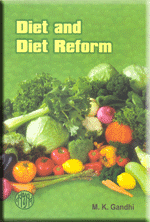
P.O. SEVAGRAM, DIST.WARDHA 442102, MS, INDIA. Phone: 91-7152-284753
FOUNDED BY MAHATMA GANDHI IN 1936
DIET AND DIET REFORM

DIET AND DIET REFORM
Table of Contents
PART-I
- SECTION I: General
- My Faith In Vegetarianism
- The Moral Basis of Vegetarianism
- Diet For Brahmacharya
- Green and Dietetic Ahimsa
- 'Food Faddists'
- Unfired Food Experiment
- Unfired Food
- Unfired Food
- Unfired Food
- National Food
- Minimum Diet
- For Four Rupees A Month
- A Talk to Village Workers
- Minimum Diet
- Plea for More Fruits
- Carrion-eating
- SECTION II : Rice, Wheat and Gur
- SECTION III : Soya Beans and Ground-nuts
- SECTION IV : Green Leaves, etc.
- SECTION V : Milk
- SECTION VI : Ghee and Oil
PART-II
- SECTION I : General
- Precautions Against Ills of The Season (M.D.)
- Dietetic Changes (M.D.)
- Mortification of The Flesh (M.D.)
- Vitamins - I (P. C. Ghosh)
- Vitamins - II (P. C. Ghosh)
- Physiological Basis of Nutrition
- Are you acid? (H. C. Menkel)
- What And How Much To Eat? (H. C. Menkel)
- Question on Diet (H. C. Menkel)
- Improved Diets (A. K.)
- Place of Cereals in Food (I. Amin)
- An Experiment in National Diet (Pyarelal)
- Revealing Figures (A. K.)
- SECTION II : Rice, Wheat and Gur
- The Miracle of Unpolished Rice (M.D.)
- Unpolished v. Polished Rice (Prof. Basu)
- Saving Cereals (D. K. Gupta)
- Useful Suggestion (M. A. Chadray)
- White v. Brown Sugar (M. D.)
- The Havoc of Sugar (M. D.)
- Bad Teeth and Refined Carbohydrates
- Potentialities of Palm Jaggery (Gajanan Naik)
- Nira - A Nutritious Beverage (Gajanan Naik)
- SECTION III : Soya Beans and Ground-nuts
- Warning against Soya Beans (M. D.)
- Soya Beans (M.D.)
- Soya Bean Recipes
- A Soya Bean Book (M. D.)
- The Utility of The Ground-nut (A. K.)
- SECTION IV : Fruit
- The Merit of Amla (A. K.)
- SECTION V : Milks
- Kimmed Milk and Buttermilk (W. R. Aykroyd and S. C. Dasgupta)
- SECTION VI : Ghee And Oil
- Edible Oils (P. C. Ghosh)
- Blindness At A Price (J. C. Kumarappa)
- Nakali Ghee (J. C. Kumarappa)
- SECTION VII : Tea
- Another Rising Menance (J. C. Kumarappa)
- Non-English Words With Their Meanings
About This Book
Written by : M. K. Gandhi
Edited by : Bharatan Kumarappa
First Edition : 5,000 copies, July 1949
ISBN : 81-7229-062-4
Printed and Published by : Jitendra T. Desai
Navajivan Mudranalaya,
Ahemadabad-380014
India
© Navajivan Trust, 1949
Download
Chapter 64 : Warning Against Soya Beans
A friend uttered a warning which has considerable significance. He said: "I am quite in favour of the reforms you suggest. You may put as much emphasis as you like on the importance of vitamins in our diet. But please don't let in enemies unawares. Thus, for instance, one of the things much boomed about nowadays is soya beans. I agree that they are rich in proteins. But is it certain that our mung, udad, massoor, chola, peas, and such other legumes are very inferior to this exotic from China and Japan? I have an impression that all these should be almost equal in value to the now famous soya bean which seems to belong to the same botanical order. And even assuming that the soya bean is richer in protein, why should we not be satisfied with our indigenous beans? You, perhaps, do not see my difficulty. You agree that for articles of diet and clothing no country should be dependent on any other. Our country was completely self-contained in both these half a century or more ago. Foreign cloth now floods our market, and foreign wheat and foreign flour and foreign milk-powder and foreign butter now threaten our independence in the matter of foodstuffs. Cannot we do without this stuff which may ultimately cost us dear?"
"I quite agree. But we have begun to grow soya beans in various parts of the country, and there is no reason why we should not be able to produce all the beans we need."
"I know, I know. What we regard as successful experiments are being made. The Punjab Agricultural Reports summarizes results of the experiments carried out on Punjab experimental farms, and they are encouraging. The produce of what is described as Pusa white and Punjab yellow and other varieties ranged from 9 to 12 maunds an acre, and the report says that soya beans may easily be tried as a substitute for cotton. I am certainly in favour of these experiments. But I want you to realize that these experiments are made on farms where they have hardly any regard to expenditure. I have no doubt that foreign countries can produce these beans much cheaper than we can, and just as foreign countries have beaten us in the export trade of ground-nuts, which is now seriously threatened, I should not be surprised if, after soya beans became the fashion in our country, our market were glutted with foreign soya beans. I would, therefore, utter this note of warning for what it may be be worth."
Our friend needs no assurance that the warning will be heeded, and that not until the soya bean has been found a practical proposition for our average farmer, working with his normal implements and resources, will it be recommended by us for general acceptance.
M.D.,
Harijan,
24-8-1935